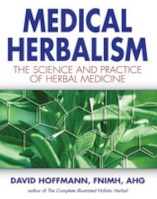 |
Full Title: | Medical Herbalism The Science and Practice of Herbal Medicine |
|---|---|---|
| Author(s): | David Hoffmann, FNIMH, AHG | |
| Publishing / Edition: | Healing Arts Press, 2003 |
 |
Full Title: | Medical Herbalism The Science and Practice of Herbal Medicine |
|---|---|---|
| Author(s): | David Hoffmann, FNIMH, AHG | |
| Publishing / Edition: | Healing Arts Press, 2003 |